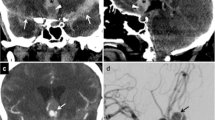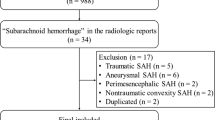Abstract
Determining the rupture source is imperative in patient with aneurysmal subarachnoid hemorrhage (SAH). About one third of SAH cases with multiple intracranial aneurysms cannot be certain of the rupture source according to the hemorrhage pattern. This study aims to identify of the rupture source in patients with multiple intracranial aneurysms by fusing SAH data and computed tomography angiography (CTA) data. This retrospective study included 52 aneurysmal SAH patients with multiple intracranial aneurysms. In the 52 patients, 36 had definitive hemorrhage patterns on computed tomography imaging. And the other 16 patients had non-definitive hemorrhage patterns, which were bewildered for us to determine the ruptured aneurysms. Fusion of SAH data and CTA data was performed to demonstrate the spatial relationship between the SAH with each aneurysm by using the 3D Slicer software. For the patients with definitive bleed patterns, all of the suspected ruptured aneurysms were confirmed to be accurate according to the surgical records. Interestingly, the suspected rupture sources were correct in 14 of 16 patients with non-definitive hemorrhage patterns. For all 52 patients with multiple intracranial aneurysms, the ruptured aneurysms were identified in 50 cases (96.2%). In conclusion, fusion of SAH data and CTA data can precisely demonstrate the spatial relationship between the SAH with each aneurysm, which is helpful to determine the ruptured aneurysm in patients with multiple intracranial aneurysms.

Similar content being viewed by others
References
Connolly EJ, Rabinstein AA, Carhuapoma JR, Derdeyn CP, Dion J, Higashida RT, Hoh BL, Kirkness CJ, Naidech AM, Ogilvy CS, Patel AB, Thompson BG, Vespa P (2012) Guidelines for the management of aneurysmal subarachnoid hemorrhage: a guideline for healthcare professionals from the American Heart Association/american Stroke Association. Stroke 43:1711–1737. https://doi.org/10.1161/STR.0b013e3182587839
Backes D, Vergouwen MD, Velthuis BK, van der Schaaf IC, Bor AS, Algra A, Rinkel GJ (2014) Difference in aneurysm characteristics between ruptured and unruptured aneurysms in patients with multiple intracranial aneurysms. Stroke 45:1299–1303. https://doi.org/10.1161/STROKEAHA.113.004421
Orning JL, Shakur SF, Alaraj A, Behbahani M, Charbel FT, Aletich VA, Amin-Hanjani S (2018) Accuracy in identifying the source of subarachnoid hemorrhage in the setting of multiple intracranial aneurysms. Neurosurgery 83:62–68. https://doi.org/10.1093/neuros/nyx339
Inagawa T (2009) Incidence and risk factors for multiple intracranial saccular aneurysms in patients with subarachnoid hemorrhage in Izumo City, Japan. Acta Neurochir 151:1623–1630. https://doi.org/10.1007/s00701-009-0479-y
Kaminogo M, Yonekura M, Shibata S (2003) Incidence and outcome of multiple intracranial aneurysms in a defined population. Stroke 34:16–21. https://doi.org/10.1161/01.str.0000046763.48330.ad
Rinne J, Hernesniemi J, Niskanen M, Vapalahti M (1995) Management outcome for multiple intracranial aneurysms. Neurosurgery 36:31–38. https://doi.org/10.1227/00006123-199501000-00003
Inagawa T (1990) Multiple intracranial aneurysms in elderly patients. Acta Neurochir 106:119–126. https://doi.org/10.1007/bf01809453
Morita A, Kirino T, Hashi K, Aoki N, Fukuhara S, Hashimoto N, Nakayama T, Sakai M, Teramoto A, Tominari S, Yoshimoto T (2012) The natural course of unruptured cerebral aneurysms in a Japanese cohort. N Engl J Med 366:2474–2482. https://doi.org/10.1056/NEJMoa1113260
Greving JP, Rinkel GJ, Buskens E, Algra A (2009) Cost-effectiveness of preventive treatment of intracranial aneurysms: new data and uncertainties. Neurology 73(4):258–265. https://doi.org/10.1212/01.wnl.0b013e3181a2a4ea
Hino A, Fujimoto M, Iwamoto Y, Yamaki T, Katsumori T (2000) False localization of rupture site in patients with multiple cerebral aneurysms and subarachnoid hemorrhage. Neurosurgery 46:825–830. https://doi.org/10.1097/00006123-200004000-00011
Lee KC, Joo JY, Lee KS (1996) False localization of rupture by computed tomography in bilateral internal carotid artery aneurysms. Surg Neurol 45:435–441. https://doi.org/10.1016/0090-3019(95)00409-2
de Rooij NK, Velthuis BK, Algra A, Rinkel GJ (2009) Configuration of the circle of Willis, direction of flow, and shape of the aneurysm as risk factors for rupture of intracranial aneurysms. J Neurol 256:45–50. https://doi.org/10.1007/s00415-009-0028-x
Raghavan ML, Ma B, Harbaugh RE (2005) Quantified aneurysm shape and rupture risk. J Neurosurg 102:355–362. https://doi.org/10.3171/jns.2005.102.2.0355
Lauric A, Baharoglu MI, Malek AM (2012) Ruptured status discrimination performance of aspect ratio, height/width, and bottleneck factor is highly dependent on aneurysm sizing methodology. Neurosurgery 71:38–45. https://doi.org/10.1227/NEU.0b013e3182503bf9
Nader-Sepahi A, Casimiro M, Sen J, Kitchen ND (2004) Is aspect ratio a reliable predictor of intracranial aneurysm rupture? Neurosurgery 54:1343–1348. https://doi.org/10.1227/01.neu.0000124482.03676.8b
Hoh BL, Sistrom CL, Firment CS, Fautheree GL, Velat GJ, Whiting JH, Reavey-Cantwell JF, Lewis SB (2007) Bottleneck factor and height-width ratio: association with ruptured aneurysms in patients with multiple cerebral aneurysms. Neurosurgery 61:716–723. https://doi.org/10.1227/01.NEU.0000298899.77097.BF
Matsukawa H, Uemura A, Fujii M, Kamo M, Takahashi O, Sumiyoshi S (2013) Morphological and clinical risk factors for the rupture of anterior communicating artery aneurysms. J Neurosurg 118:978–983. https://doi.org/10.3171/2012.11.JNS121210
Lin N, Ho A, Gross BA, Pieper S, Frerichs KU, Day AL, Du R (2012) Differences in simple morphological variables in ruptured and unruptured middle cerebral artery aneurysms. J Neurosurg 117:913–919. https://doi.org/10.3171/2012.7.JNS111766
San MRD, Yilmaz H, Dehdashti AR, Alimenti A, de Tribolet N, Rufenacht DA (2006) The perianeurysmal environment: influence on saccular aneurysm shape and rupture. AJNR Am J Neuroradiol 27:504–512
Satoh T, Omi M, Ohsako C, Katsumata A, Yoshimoto Y, Tsuchimoto S, Onoda K, Tokunaga K, Sugiu K, Date I (2005) Influence of perianeurysmal environment on the deformation and bleb formation of the unruptured cerebral aneurysm: assessment with fusion imaging of 3D MR cisternography and 3D MR angiography. AJNR Am J Neuroradiol 26:2010–2018
Sugiu K, Jean B, San MRD, Martin JB, Delavelle J, Rufenacht DA (2000) Influence of the perianeurysmal environment on rupture of cerebral aneurysms. Preliminary observation. Interv Neuroradiol 6:65–70. https://doi.org/10.1177/15910199000060S107
Ryu CW, Kwon OK, Koh JS, Kim EJ (2011) Analysis of aneurysm rupture in relation to the geometric indices: aspect ratio, volume, and volume-to-neck ratio. Neuroradiology 53:883–889. https://doi.org/10.1007/s00234-010-0804-4
Beck J, Rohde S, El BM, Zimmermann M, Berkefeld J, Seifert V, Raabe A (2003) Difference in configuration of ruptured and unruptured intracranial aneurysms determined by biplanar digital subtraction angiography. Acta Neurochir 145:861–865. https://doi.org/10.1007/s00701-003-0124-0
Bjorkman J, Frosen J, Tahtinen O, Backes D, Huttunen T, Harju J, Huttunen J, Kurki MI, von Und ZFM, Koivisto T, Manninen H, Jaaskelainen JE, Lindgren AE (2017) Irregular shape identifies ruptured intracranial aneurysm in subarachnoid hemorrhage patients with multiple aneurysms. Stroke 48:1986–1989. https://doi.org/10.1161/STROKEAHA.117.017147
Steven AJ, Milburn JM, Gulotta P, Gandhi D (2016) Clinical images: vessel wall imaging in the management of subarachnoid hemorrhage and multiple intracranial aneurysms. Ochsner J 16:199–202
Swartz RH, Bhuta SS, Farb RI, Agid R, Willinsky RA, Terbrugge KG, Butany J, Wasserman BA, Johnstone DM, Silver FL, Mikulis DJ (2009) Intracranial arterial wall imaging using high-resolution 3-tesla contrast-enhanced MRI. Neurology 72:627–634. https://doi.org/10.1212/01.wnl.0000342470.69739.b3
Matouk CC, Mandell DM, Gunel M, Bulsara KR, Malhotra A, Hebert R, Johnson MH, Mikulis DJ, Minja FJ (2013) Vessel wall magnetic resonance imaging identifies the site of rupture in patients with multiple intracranial aneurysms: proof of principle. Neurosurgery 72:492–496. https://doi.org/10.1227/NEU.0b013e31827d1012
Dieleman N, van der Kolk AG, Zwanenburg JJ, Harteveld AA, Biessels GJ, Luijten PR, Hendrikse J (2014) Imaging intracranial vessel wall pathology with magnetic resonance imaging: current prospects and future directions. Circulation 130:192–201. https://doi.org/10.1161/CIRCULATIONAHA.113.006919
Nagahata S, Nagahata M, Obara M, Kondo R, Minagawa N, Sato S, Sato S, Mouri W, Saito S, Kayama T (2016) Wall enhancement of the intracranial aneurysms revealed by magnetic resonance vessel wall imaging using three-dimensional turbo spin-echo sequence with motion-sensitized driven-equilibrium: a sign of ruptured aneurysm? Clin Neuroradiol 26:277–283. https://doi.org/10.1007/s00062-014-0353-z
Edjlali M, Gentric JC, Regent-Rodriguez C, Trystram D, Hassen WB, Lion S, Nataf F, Raymond J, Wieben O, Turski P, Meder JF, Oppenheim C, Naggara O (2014) Does aneurysmal wall enhancement on vessel wall MRI help to distinguish stable from unstable intracranial aneurysms? Stroke 45:3704–3706. https://doi.org/10.1161/STROKEAHA.114.006626
Zolnourian A, Borg N, Akhigbe T, Macdonald J, Bulters D (2019) Vessel wall imaging after subarachnoid hemorrhage in patients with multiple intracranial aneurysms: a cautionary case. World Neurosurg 127:414–417. https://doi.org/10.1016/j.wneu.2019.04.130
Acknowledgments
We are grateful to Dr. Xiaolei Chen, Xinghua Xu, and Zhichao Gan for their help of 3D Slicer software technical assistance.
Funding
The study was supported by the National Natural Science Foundation of China (grant number 81402455).
Author information
Authors and Affiliations
Corresponding authors
Ethics declarations
Conflict of interest
The authors declare that they have no conflict of interest.
Statement of ethics
This work was conducted ethically in accordance with the World Medical Association Declaration of Helsinki. Institutional Review Board (IRB) approval was obtained from Chinese General Hospital of PLA. Informed consent was waived by the IRB as this study was comprised of retrospective medical chart review and analysis of existing data.
Additional information
Publisher’s note
Springer Nature remains neutral with regard to jurisdictional claims in published maps and institutional affiliations.
Rights and permissions
About this article
Cite this article
Yao, A., Jia, L., Li, J. et al. Fusion of subarachnoid hemorrhage data and computed tomography angiography data is helpful to identify the rupture source in patients with multiple intracranial aneurysms. Neurosurg Rev 44, 1411–1416 (2021). https://doi.org/10.1007/s10143-019-01221-1
Received:
Revised:
Accepted:
Published:
Issue Date:
DOI: https://doi.org/10.1007/s10143-019-01221-1




